engine FORD E SERIES 2002 4.G Owner's Manual
[x] Cancel search | Manufacturer: FORD, Model Year: 2002, Model line: E SERIES, Model: FORD E SERIES 2002 4.GPages: 272, PDF Size: 2.6 MB
Page 157 of 272
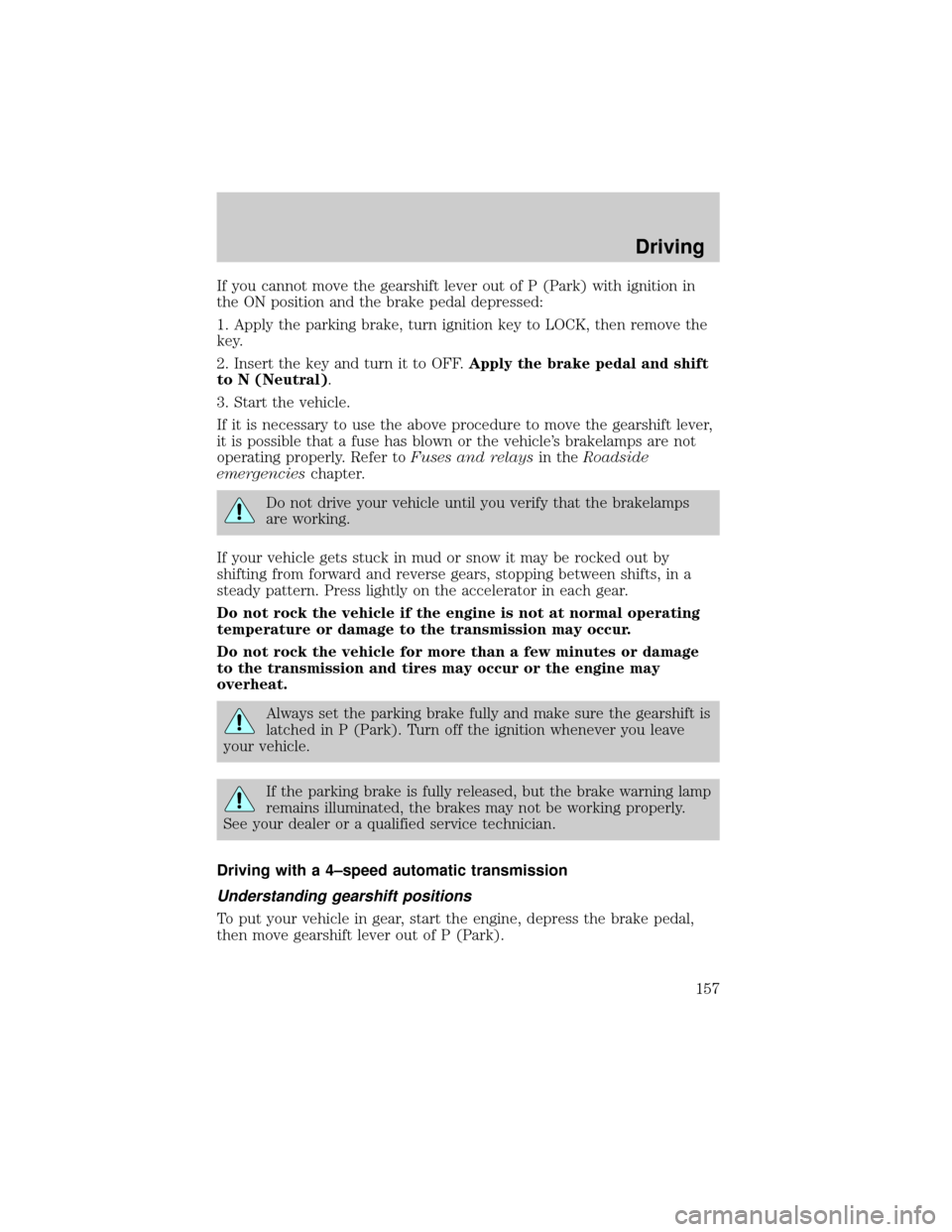
If you cannot move the gearshift lever out of P (Park) with ignition in
the ON position and the brake pedal depressed:
1. Apply the parking brake, turn ignition key to LOCK, then remove the
key.
2. Insert the key and turn it to OFF.Apply the brake pedal and shift
to N (Neutral).
3. Start the vehicle.
If it is necessary to use the above procedure to move the gearshift lever,
it is possible that a fuse has blown or the vehicle's brakelamps are not
operating properly. Refer toFuses and relaysin theRoadside
emergencieschapter.
Do not drive your vehicle until you verify that the brakelamps
are working.
If your vehicle gets stuck in mud or snow it may be rocked out by
shifting from forward and reverse gears, stopping between shifts, in a
steady pattern. Press lightly on the accelerator in each gear.
Do not rock the vehicle if the engine is not at normal operating
temperature or damage to the transmission may occur.
Do not rock the vehicle for more than a few minutes or damage
to the transmission and tires may occur or the engine may
overheat.
Always set the parking brake fully and make sure the gearshift is
latched in P (Park). Turn off the ignition whenever you leave
your vehicle.
If the parking brake is fully released, but the brake warning lamp
remains illuminated, the brakes may not be working properly.
See your dealer or a qualified service technician.
Driving with a 4±speed automatic transmission
Understanding gearshift positions
To put your vehicle in gear, start the engine, depress the brake pedal,
then move gearshift lever out of P (Park).
Driving
157
Page 159 of 272
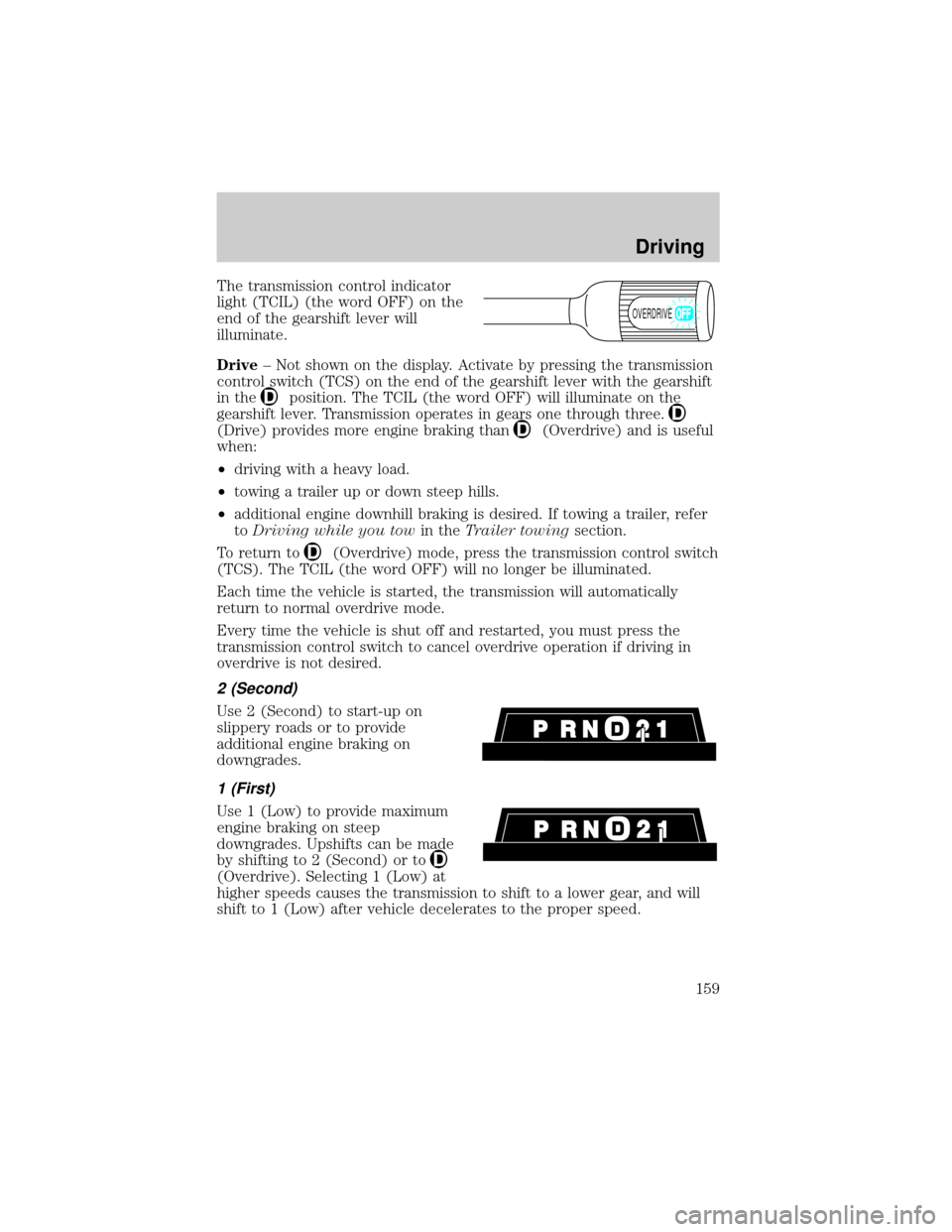
The transmission control indicator
light (TCIL) (the word OFF) on the
end of the gearshift lever will
illuminate.
Drive± Not shown on the display. Activate by pressing the transmission
control switch (TCS) on the end of the gearshift lever with the gearshift
in the
position. The TCIL (the word OFF) will illuminate on the
gearshift lever. Transmission operates in gears one through three.
(Drive) provides more engine braking than(Overdrive) and is useful
when:
²driving with a heavy load.
²towing a trailer up or down steep hills.
²additional engine downhill braking is desired. If towing a trailer, refer
toDriving while you towin theTrailer towingsection.
To return to
(Overdrive) mode, press the transmission control switch
(TCS). The TCIL (the word OFF) will no longer be illuminated.
Each time the vehicle is started, the transmission will automatically
return to normal overdrive mode.
Every time the vehicle is shut off and restarted, you must press the
transmission control switch to cancel overdrive operation if driving in
overdrive is not desired.
2 (Second)
Use 2 (Second) to start-up on
slippery roads or to provide
additional engine braking on
downgrades.
1 (First)
Use 1 (Low) to provide maximum
engine braking on steep
downgrades. Upshifts can be made
by shifting to 2 (Second) or to
(Overdrive). Selecting 1 (Low) at
higher speeds causes the transmission to shift to a lower gear, and will
shift to 1 (Low) after vehicle decelerates to the proper speed.
OVERDRIVE
Driving
159
Page 160 of 272

Forced Downshifts
To gain acceleration in(Overdrive) or Drive (O/D OFF) when
passing another vehicle, push the accelerator to the floor. The
transmission will downshift to the appropriate gear: third, second or first
gear.
Shift strategy (4R100 automatic transmission)
To account for customer driving habits and conditions, your 4R100
automatic transmission electronically controls the shift quality by using
an adaptive learning strategy. The adaptive learning strategy is
maintained by power from the battery. When the battery is disconnected
or a new battery is installed, the transmission must relearn its adaptive
strategy. Optimal shifting will resume within a few hundred kilometers
(miles) of operation.
If the shift quality does not improve within a few hundred
kilometers (miles) of operation, or if the downshifts and other
throttle conditions do not function normally, see your dealer or a
qualified service technician as soon as possible.
DRIVING THROUGH WATER
Do not drive quickly through standing water, especially if the depth is
unknown. Traction or brake capability may be limited and if the ignition
system gets wet, your engine may stall. Water may also enter your
engine's air intake and severely damage your engine.
If driving through deep or standing water is unavoidable, proceed very
slowly. Never drive through water that is higher than the bottom of the
hubs (for trucks) or the bottom of the wheel rims (for cars).
Once through the water, always try the brakes. Wet brakes do not stop
the vehicle as effectively as dry brakes. Drying can be improved by
moving your vehicle slowly while applying light pressure on the brake
pedal.
Driving through deep water where the transmission vent tube is
submerged may allow water into the transmission and cause
internal transmission damage.
VEHICLE LOADING
Before loading a vehicle, familiarize yourself with the following terms:
Driving
160
Page 161 of 272
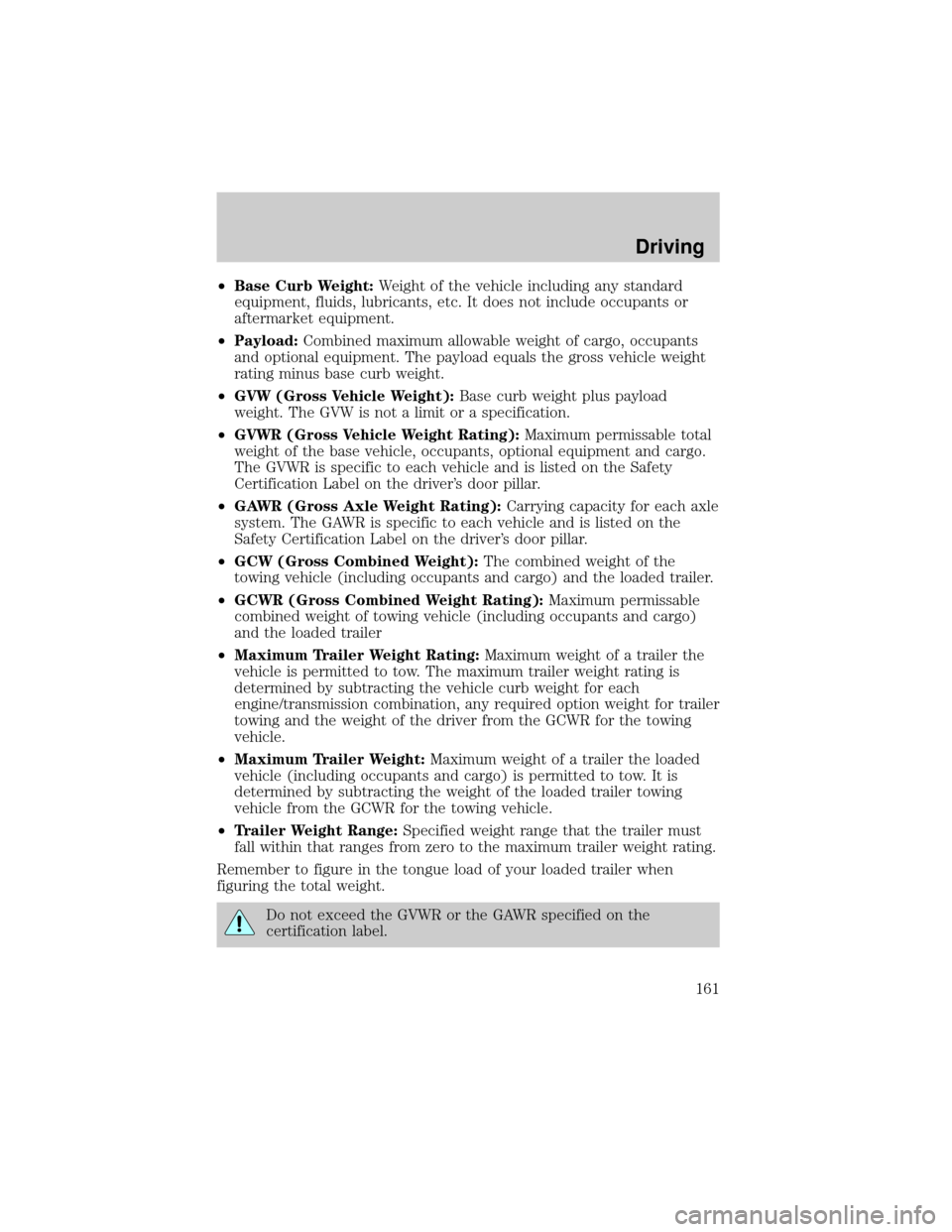
²Base Curb Weight:Weight of the vehicle including any standard
equipment, fluids, lubricants, etc. It does not include occupants or
aftermarket equipment.
²Payload:Combined maximum allowable weight of cargo, occupants
and optional equipment. The payload equals the gross vehicle weight
rating minus base curb weight.
²GVW (Gross Vehicle Weight):Base curb weight plus payload
weight. The GVW is not a limit or a specification.
²GVWR (Gross Vehicle Weight Rating):Maximum permissable total
weight of the base vehicle, occupants, optional equipment and cargo.
The GVWR is specific to each vehicle and is listed on the Safety
Certification Label on the driver's door pillar.
²GAWR (Gross Axle Weight Rating):Carrying capacity for each axle
system. The GAWR is specific to each vehicle and is listed on the
Safety Certification Label on the driver's door pillar.
²GCW (Gross Combined Weight):The combined weight of the
towing vehicle (including occupants and cargo) and the loaded trailer.
²GCWR (Gross Combined Weight Rating):Maximum permissable
combined weight of towing vehicle (including occupants and cargo)
and the loaded trailer
²Maximum Trailer Weight Rating:Maximum weight of a trailer the
vehicle is permitted to tow. The maximum trailer weight rating is
determined by subtracting the vehicle curb weight for each
engine/transmission combination, any required option weight for trailer
towing and the weight of the driver from the GCWR for the towing
vehicle.
²Maximum Trailer Weight:Maximum weight of a trailer the loaded
vehicle (including occupants and cargo) is permitted to tow. It is
determined by subtracting the weight of the loaded trailer towing
vehicle from the GCWR for the towing vehicle.
²Trailer Weight Range:Specified weight range that the trailer must
fall within that ranges from zero to the maximum trailer weight rating.
Remember to figure in the tongue load of your loaded trailer when
figuring the total weight.
Do not exceed the GVWR or the GAWR specified on the
certification label.
Driving
161
Page 163 of 272
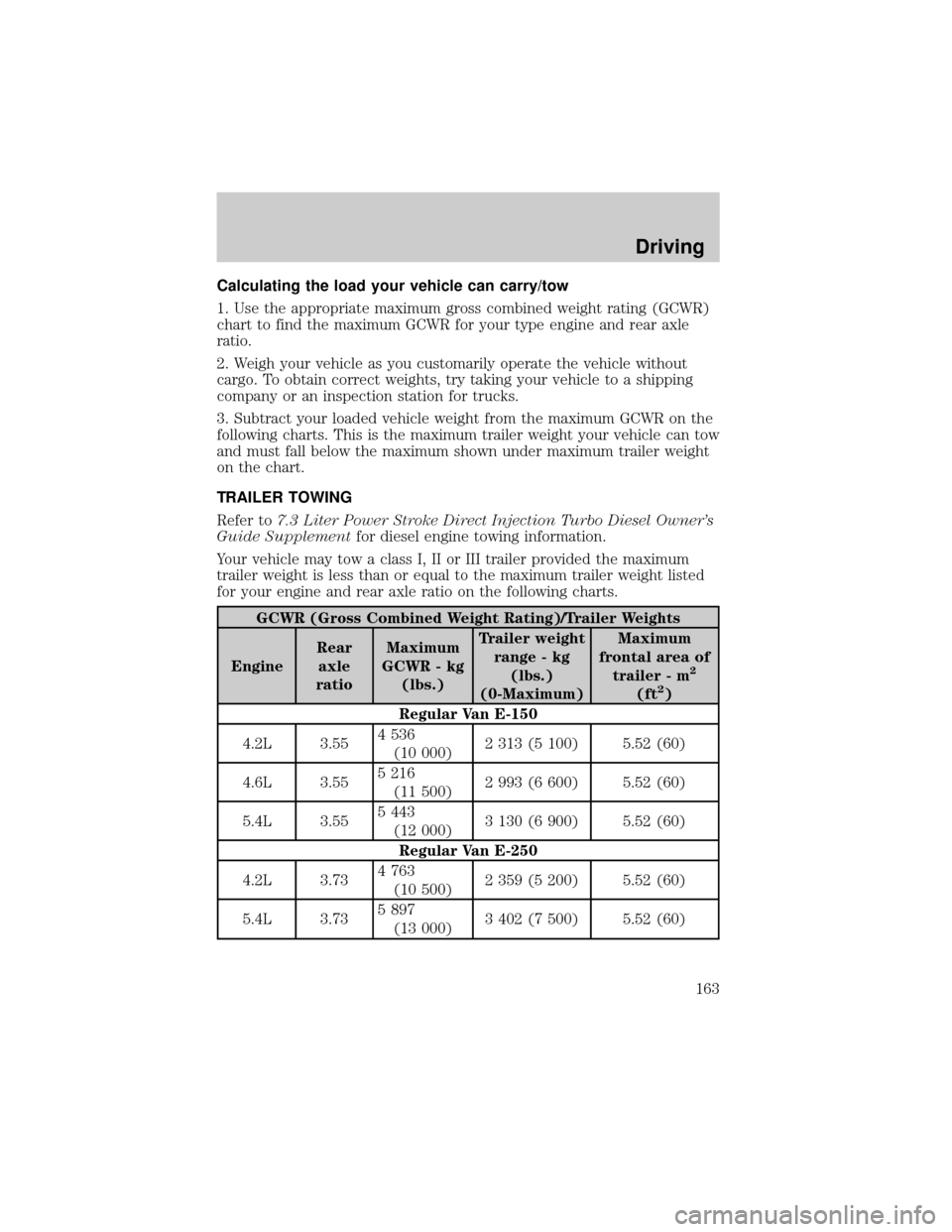
Calculating the load your vehicle can carry/tow
1. Use the appropriate maximum gross combined weight rating (GCWR)
chart to find the maximum GCWR for your type engine and rear axle
ratio.
2. Weigh your vehicle as you customarily operate the vehicle without
cargo. To obtain correct weights, try taking your vehicle to a shipping
company or an inspection station for trucks.
3. Subtract your loaded vehicle weight from the maximum GCWR on the
following charts. This is the maximum trailer weight your vehicle can tow
and must fall below the maximum shown under maximum trailer weight
on the chart.
TRAILER TOWING
Refer to7.3 Liter Power Stroke Direct Injection Turbo Diesel Owner's
Guide Supplementfor diesel engine towing information.
Your vehicle may tow a class I, II or III trailer provided the maximum
trailer weight is less than or equal to the maximum trailer weight listed
for your engine and rear axle ratio on the following charts.
GCWR (Gross Combined Weight Rating)/Trailer Weights
EngineRear
axle
ratioMaximum
GCWR - kg
(lbs.)Trailer weight
range - kg
(lbs.)
(0-Maximum)Maximum
frontal area of
trailer - m
2
(ft2)
Regular Van E-150
4.2L 3.554 536
(10 000)2 313 (5 100) 5.52 (60)
4.6L 3.555 216
(11 500)2 993 (6 600) 5.52 (60)
5.4L 3.555 443
(12 000)3 130 (6 900) 5.52 (60)
Regular Van E-250
4.2L 3.734 763
(10 500)2 359 (5 200) 5.52 (60)
5.4L 3.735 897
(13 000)3 402 (7 500) 5.52 (60)
Driving
163
Page 164 of 272
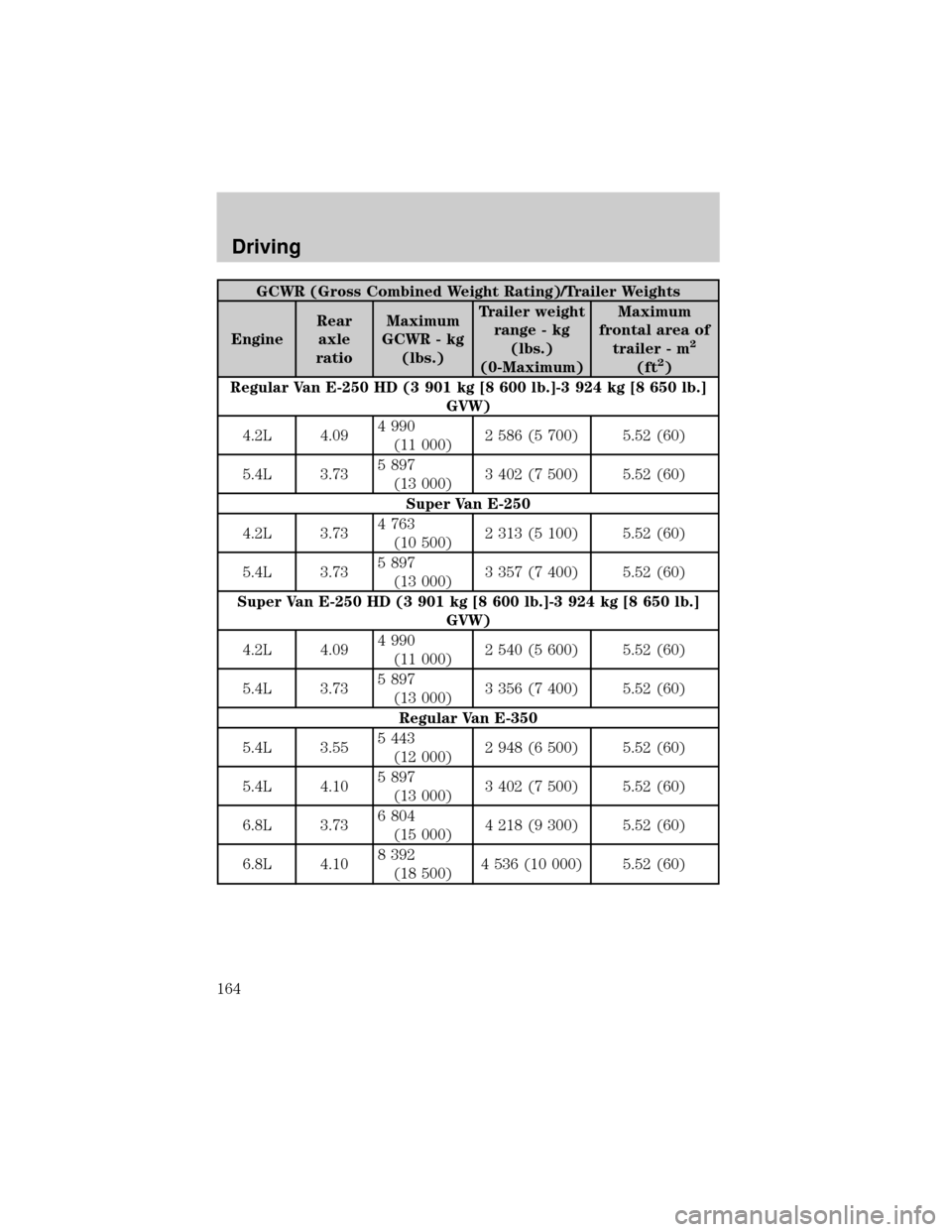
GCWR (Gross Combined Weight Rating)/Trailer Weights
EngineRear
axle
ratioMaximum
GCWR - kg
(lbs.)Trailer weight
range - kg
(lbs.)
(0-Maximum)Maximum
frontal area of
trailer - m
2
(ft2)
Regular Van E-250 HD (3 901 kg [8 600 lb.]-3 924 kg [8 650 lb.]
GVW)
4.2L 4.094 990
(11 000)2 586 (5 700) 5.52 (60)
5.4L 3.735 897
(13 000)3 402 (7 500) 5.52 (60)
Super Van E-250
4.2L 3.734 763
(10 500)2 313 (5 100) 5.52 (60)
5.4L 3.735 897
(13 000)3 357 (7 400) 5.52 (60)
Super Van E-250 HD (3 901 kg [8 600 lb.]-3 924 kg [8 650 lb.]
GVW)
4.2L 4.094 990
(11 000)2 540 (5 600) 5.52 (60)
5.4L 3.735 897
(13 000)3 356 (7 400) 5.52 (60)
Regular Van E-350
5.4L 3.555 443
(12 000)2 948 (6 500) 5.52 (60)
5.4L 4.105 897
(13 000)3 402 (7 500) 5.52 (60)
6.8L 3.736 804
(15 000)4 218 (9 300) 5.52 (60)
6.8L 4.108 392
(18 500)4 536 (10 000) 5.52 (60)
Driving
164
Page 165 of 272
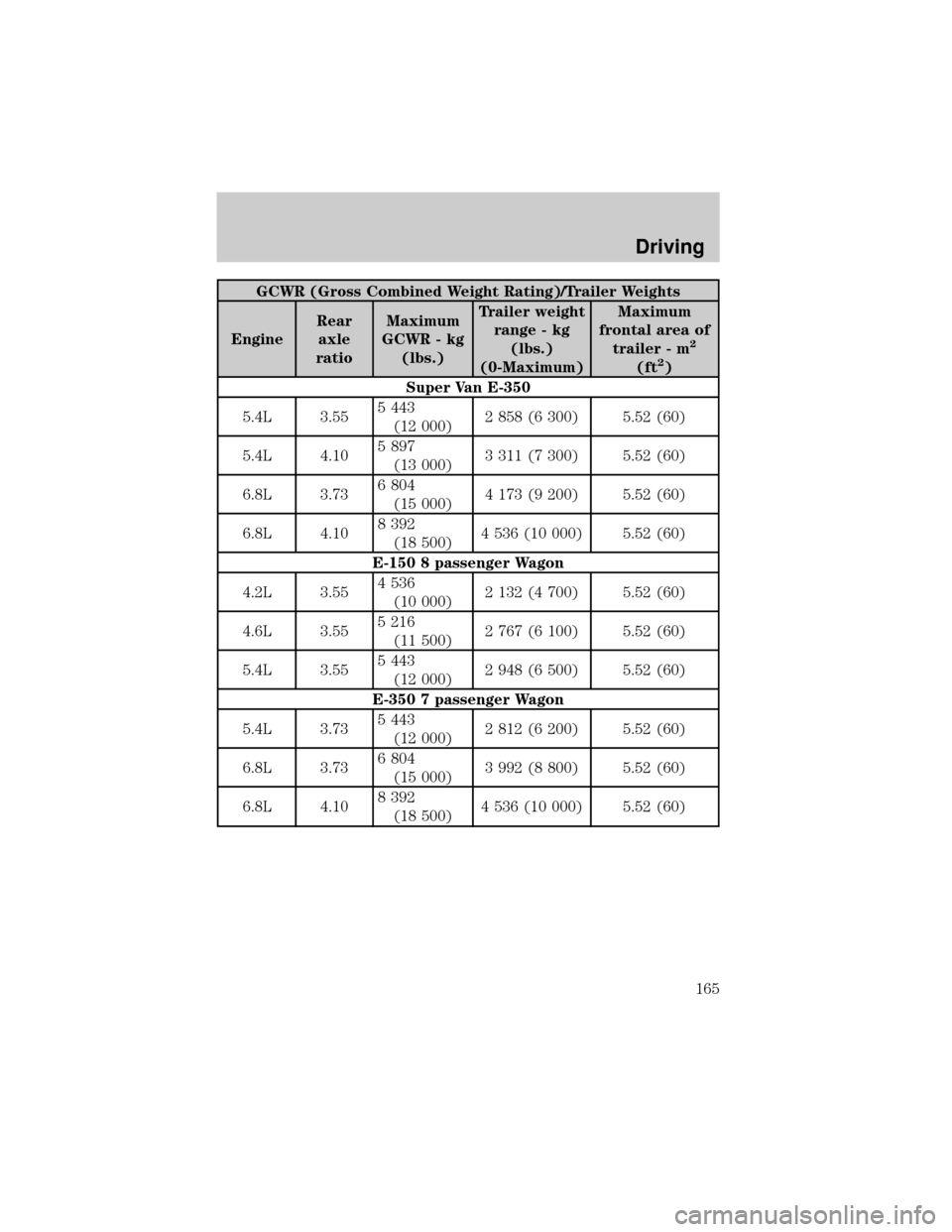
GCWR (Gross Combined Weight Rating)/Trailer Weights
EngineRear
axle
ratioMaximum
GCWR - kg
(lbs.)Trailer weight
range - kg
(lbs.)
(0-Maximum)Maximum
frontal area of
trailer - m
2
(ft2)
Super Van E-350
5.4L 3.555 443
(12 000)2 858 (6 300) 5.52 (60)
5.4L 4.105 897
(13 000)3 311 (7 300) 5.52 (60)
6.8L 3.736 804
(15 000)4 173 (9 200) 5.52 (60)
6.8L 4.108 392
(18 500)4 536 (10 000) 5.52 (60)
E-150 8 passenger Wagon
4.2L 3.554 536
(10 000)2 132 (4 700) 5.52 (60)
4.6L 3.555 216
(11 500)2 767 (6 100) 5.52 (60)
5.4L 3.555 443
(12 000)2 948 (6 500) 5.52 (60)
E-350 7 passenger Wagon
5.4L 3.735 443
(12 000)2 812 (6 200) 5.52 (60)
6.8L 3.736 804
(15 000)3 992 (8 800) 5.52 (60)
6.8L 4.108 392
(18 500)4 536 (10 000) 5.52 (60)
Driving
165
Page 166 of 272
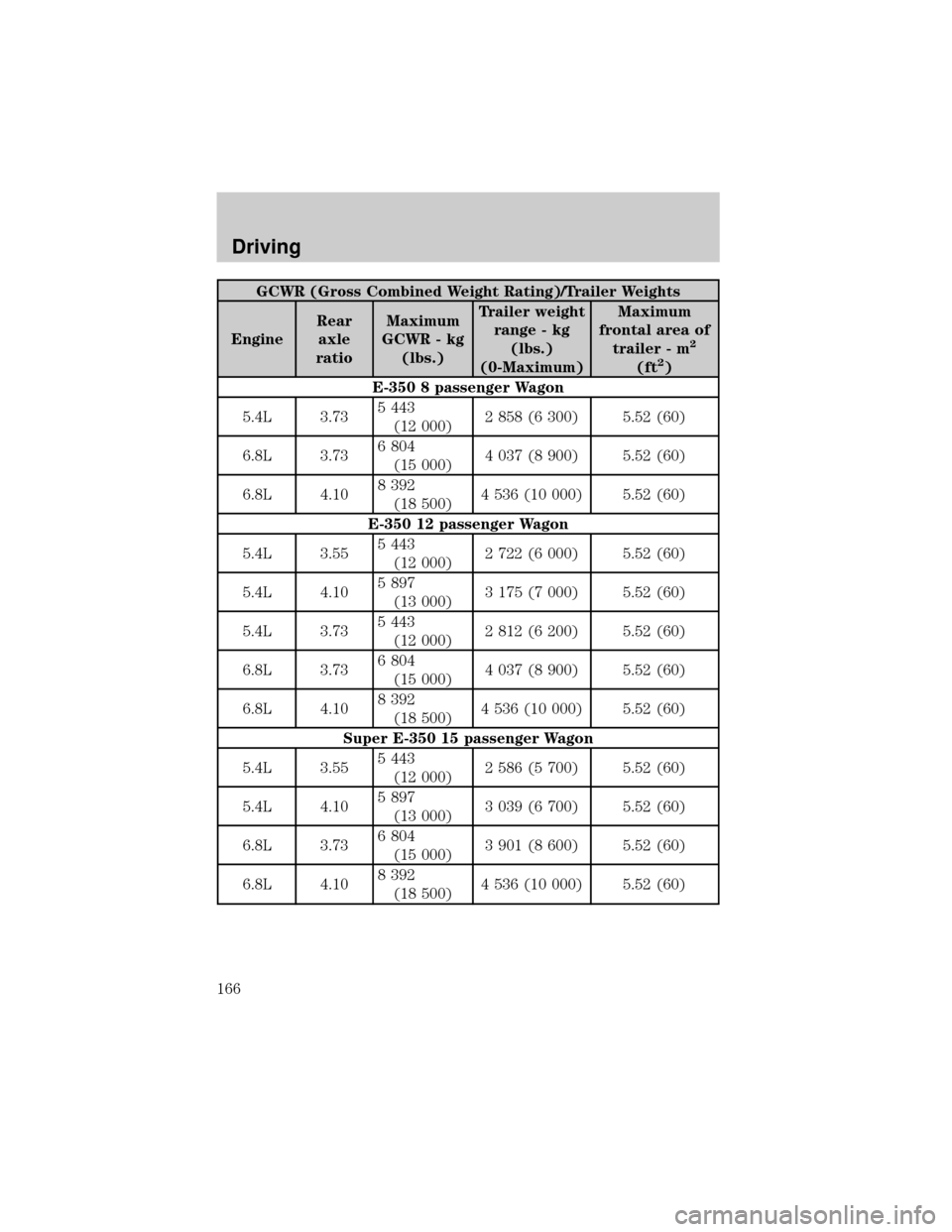
GCWR (Gross Combined Weight Rating)/Trailer Weights
EngineRear
axle
ratioMaximum
GCWR - kg
(lbs.)Trailer weight
range - kg
(lbs.)
(0-Maximum)Maximum
frontal area of
trailer - m
2
(ft2)
E-350 8 passenger Wagon
5.4L 3.735 443
(12 000)2 858 (6 300) 5.52 (60)
6.8L 3.736 804
(15 000)4 037 (8 900) 5.52 (60)
6.8L 4.108 392
(18 500)4 536 (10 000) 5.52 (60)
E-350 12 passenger Wagon
5.4L 3.555 443
(12 000)2 722 (6 000) 5.52 (60)
5.4L 4.105 897
(13 000)3 175 (7 000) 5.52 (60)
5.4L 3.735 443
(12 000)2 812 (6 200) 5.52 (60)
6.8L 3.736 804
(15 000)4 037 (8 900) 5.52 (60)
6.8L 4.108 392
(18 500)4 536 (10 000) 5.52 (60)
Super E-350 15 passenger Wagon
5.4L 3.555 443
(12 000)2 586 (5 700) 5.52 (60)
5.4L 4.105 897
(13 000)3 039 (6 700) 5.52 (60)
6.8L 3.736 804
(15 000)3 901 (8 600) 5.52 (60)
6.8L 4.108 392
(18 500)4 536 (10 000) 5.52 (60)
Driving
166
Page 167 of 272
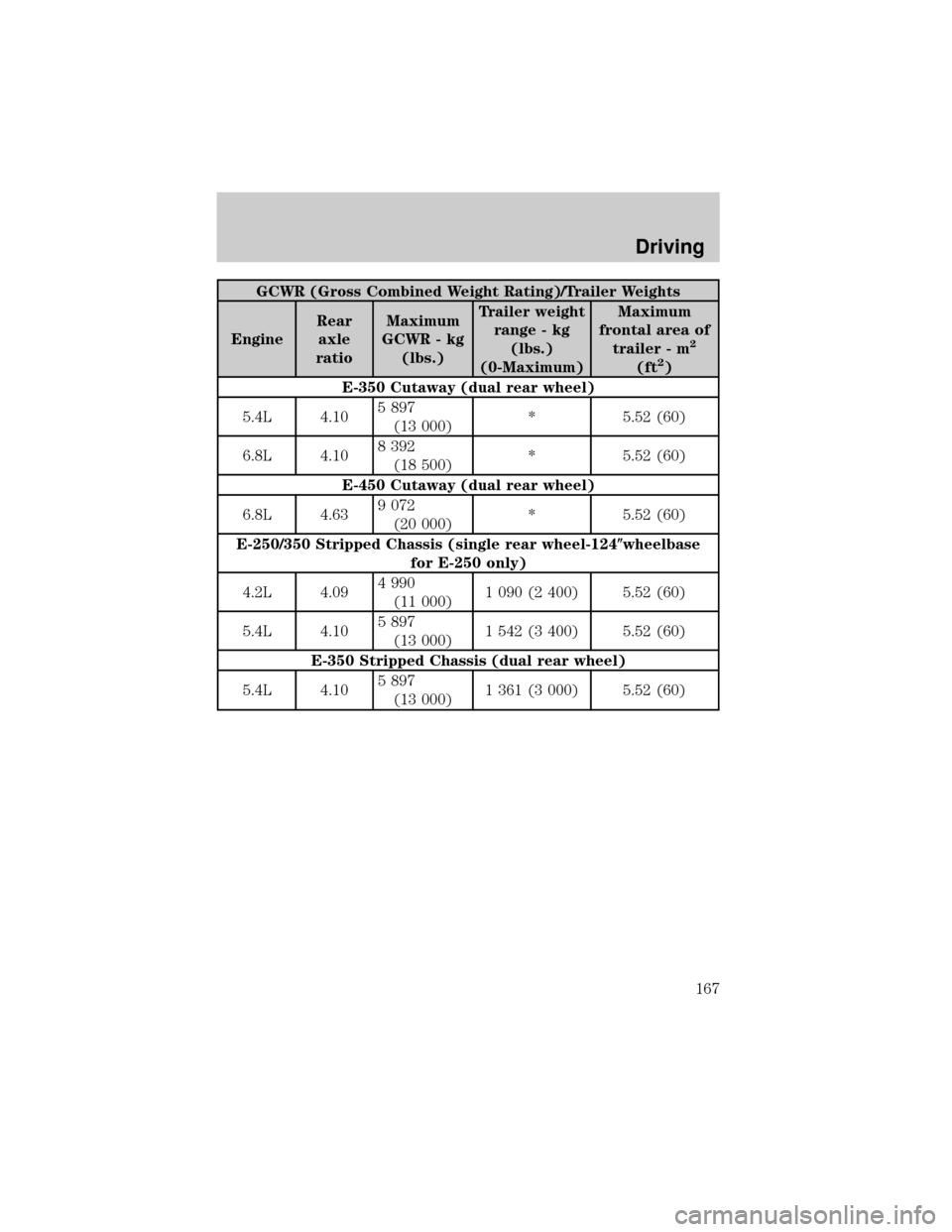
GCWR (Gross Combined Weight Rating)/Trailer Weights
EngineRear
axle
ratioMaximum
GCWR - kg
(lbs.)Trailer weight
range - kg
(lbs.)
(0-Maximum)Maximum
frontal area of
trailer - m
2
(ft2)
E-350 Cutaway (dual rear wheel)
5.4L 4.105 897
(13 000)* 5.52 (60)
6.8L 4.108 392
(18 500)* 5.52 (60)
E-450 Cutaway (dual rear wheel)
6.8L 4.639 072
(20 000)* 5.52 (60)
E-250/350 Stripped Chassis (single rear wheel-124(wheelbase
for E-250 only)
4.2L 4.094 990
(11 000)1 090 (2 400) 5.52 (60)
5.4L 4.105 897
(13 000)1 542 (3 400) 5.52 (60)
E-350 Stripped Chassis (dual rear wheel)
5.4L 4.105 897
(13 000)1 361 (3 000) 5.52 (60)
Driving
167
Page 168 of 272
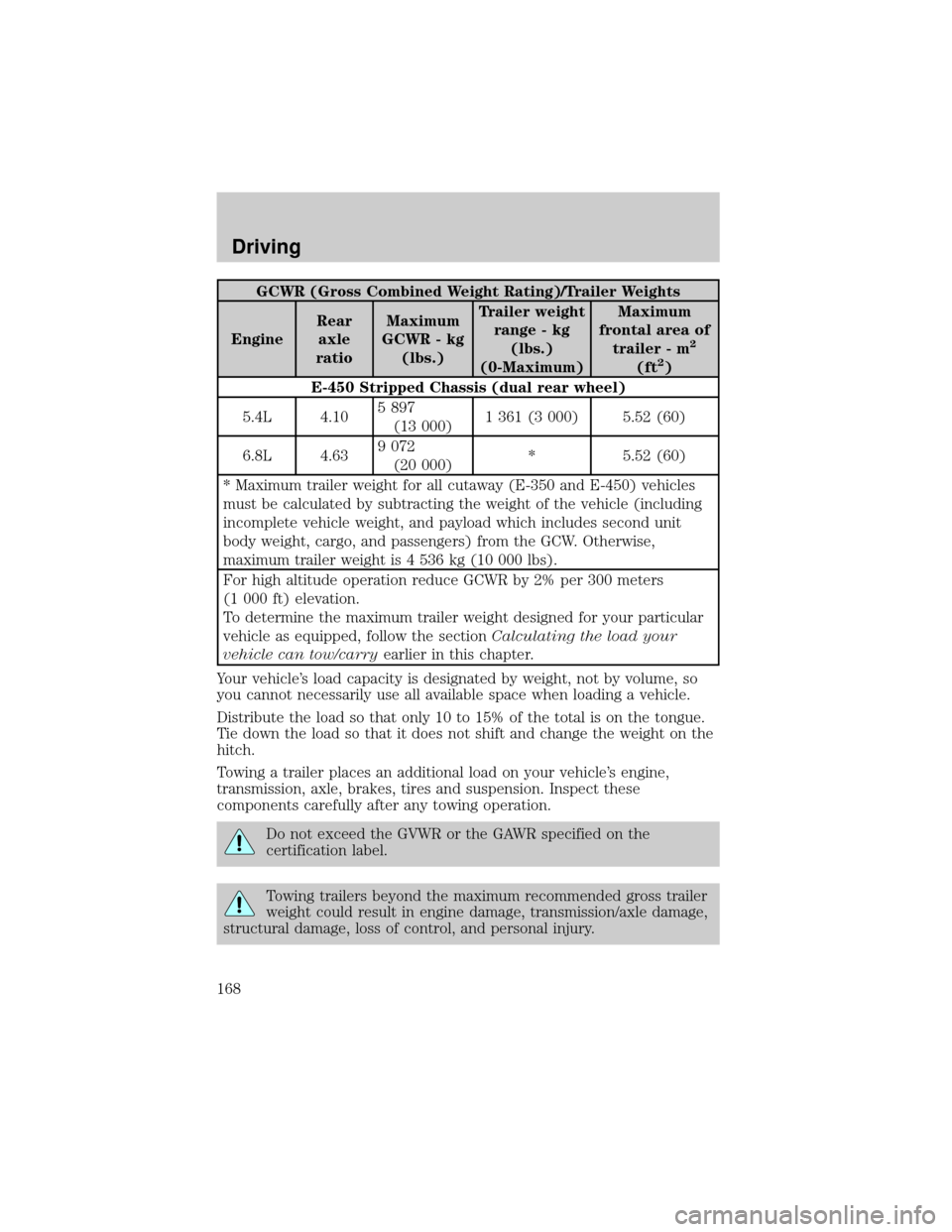
GCWR (Gross Combined Weight Rating)/Trailer Weights
EngineRear
axle
ratioMaximum
GCWR - kg
(lbs.)Trailer weight
range - kg
(lbs.)
(0-Maximum)Maximum
frontal area of
trailer - m
2
(ft2)
E-450 Stripped Chassis (dual rear wheel)
5.4L 4.105 897
(13 000)1 361 (3 000) 5.52 (60)
6.8L 4.639 072
(20 000)* 5.52 (60)
* Maximum trailer weight for all cutaway (E-350 and E-450) vehicles
must be calculated by subtracting the weight of the vehicle (including
incomplete vehicle weight, and payload which includes second unit
body weight, cargo, and passengers) from the GCW. Otherwise,
maximum trailer weight is 4 536 kg (10 000 lbs).
For high altitude operation reduce GCWR by 2% per 300 meters
(1 000 ft) elevation.
To determine the maximum trailer weight designed for your particular
vehicle as equipped, follow the sectionCalculating the load your
vehicle can tow/carryearlier in this chapter.
Your vehicle's load capacity is designated by weight, not by volume, so
you cannot necessarily use all available space when loading a vehicle.
Distribute the load so that only 10 to 15% of the total is on the tongue.
Tie down the load so that it does not shift and change the weight on the
hitch.
Towing a trailer places an additional load on your vehicle's engine,
transmission, axle, brakes, tires and suspension. Inspect these
components carefully after any towing operation.
Do not exceed the GVWR or the GAWR specified on the
certification label.
Towing trailers beyond the maximum recommended gross trailer
weight could result in engine damage, transmission/axle damage,
structural damage, loss of control, and personal injury.
Driving
168